Toan Nguyen
RoboDesign1M: A Large-scale Dataset for Robot Design Understanding
Mar 09, 2025Abstract:Robot design is a complex and time-consuming process that requires specialized expertise. Gaining a deeper understanding of robot design data can enable various applications, including automated design generation, retrieving example designs from text, and developing AI-powered design assistants. While recent advancements in foundation models present promising approaches to addressing these challenges, progress in this field is hindered by the lack of large-scale design datasets. In this paper, we introduce RoboDesign1M, a large-scale dataset comprising 1 million samples. Our dataset features multimodal data collected from scientific literature, covering various robotics domains. We propose a semi-automated data collection pipeline, enabling efficient and diverse data acquisition. To assess the effectiveness of RoboDesign1M, we conduct extensive experiments across multiple tasks, including design image generation, visual question answering about designs, and design image retrieval. The results demonstrate that our dataset serves as a challenging new benchmark for design understanding tasks and has the potential to advance research in this field. RoboDesign1M will be released to support further developments in AI-driven robotic design automation.
h-Edit: Effective and Flexible Diffusion-Based Editing via Doob's h-Transform
Mar 04, 2025Abstract:We introduce a theoretical framework for diffusion-based image editing by formulating it as a reverse-time bridge modeling problem. This approach modifies the backward process of a pretrained diffusion model to construct a bridge that converges to an implicit distribution associated with the editing target at time 0. Building on this framework, we propose h-Edit, a novel editing method that utilizes Doob's h-transform and Langevin Monte Carlo to decompose the update of an intermediate edited sample into two components: a "reconstruction" term and an "editing" term. This decomposition provides flexibility, allowing the reconstruction term to be computed via existing inversion techniques and enabling the combination of multiple editing terms to handle complex editing tasks. To our knowledge, h-Edit is the first training-free method capable of performing simultaneous text-guided and reward-model-based editing. Extensive experiments, both quantitative and qualitative, show that h-Edit outperforms state-of-the-art baselines in terms of editing effectiveness and faithfulness. Our source code is available at https://github.com/nktoan/h-edit.
Deep-Wide Learning Assistance for Insect Pest Classification
Sep 16, 2024



Abstract:Accurate insect pest recognition plays a critical role in agriculture. It is a challenging problem due to the intricate characteristics of insects. In this paper, we present DeWi, novel learning assistance for insect pest classification. With a one-stage and alternating training strategy, DeWi simultaneously improves several Convolutional Neural Networks in two perspectives: discrimination (by optimizing a triplet margin loss in a supervised training manner) and generalization (via data augmentation). From that, DeWi can learn discriminative and in-depth features of insect pests (deep) yet still generalize well to a large number of insect categories (wide). Experimental results show that DeWi achieves the highest performances on two insect pest classification benchmarks (76.44\% accuracy on the IP102 dataset and 99.79\% accuracy on the D0 dataset, respectively). In addition, extensive evaluations and ablation studies are conducted to thoroughly investigate our DeWi and demonstrate its superiority. Our source code is available at https://github.com/toannguyen1904/DeWi.
Language-Driven 6-DoF Grasp Detection Using Negative Prompt Guidance
Jul 18, 2024



Abstract:6-DoF grasp detection has been a fundamental and challenging problem in robotic vision. While previous works have focused on ensuring grasp stability, they often do not consider human intention conveyed through natural language, hindering effective collaboration between robots and users in complex 3D environments. In this paper, we present a new approach for language-driven 6-DoF grasp detection in cluttered point clouds. We first introduce Grasp-Anything-6D, a large-scale dataset for the language-driven 6-DoF grasp detection task with 1M point cloud scenes and more than 200M language-associated 3D grasp poses. We further introduce a novel diffusion model that incorporates a new negative prompt guidance learning strategy. The proposed negative prompt strategy directs the detection process toward the desired object while steering away from unwanted ones given the language input. Our method enables an end-to-end framework where humans can command the robot to grasp desired objects in a cluttered scene using natural language. Intensive experimental results show the effectiveness of our method in both benchmarking experiments and real-world scenarios, surpassing other baselines. In addition, we demonstrate the practicality of our approach in real-world robotic applications. Our project is available at https://airvlab.github.io/grasp-anything.
Crossing Linguistic Horizons: Finetuning and Comprehensive Evaluation of Vietnamese Large Language Models
Mar 05, 2024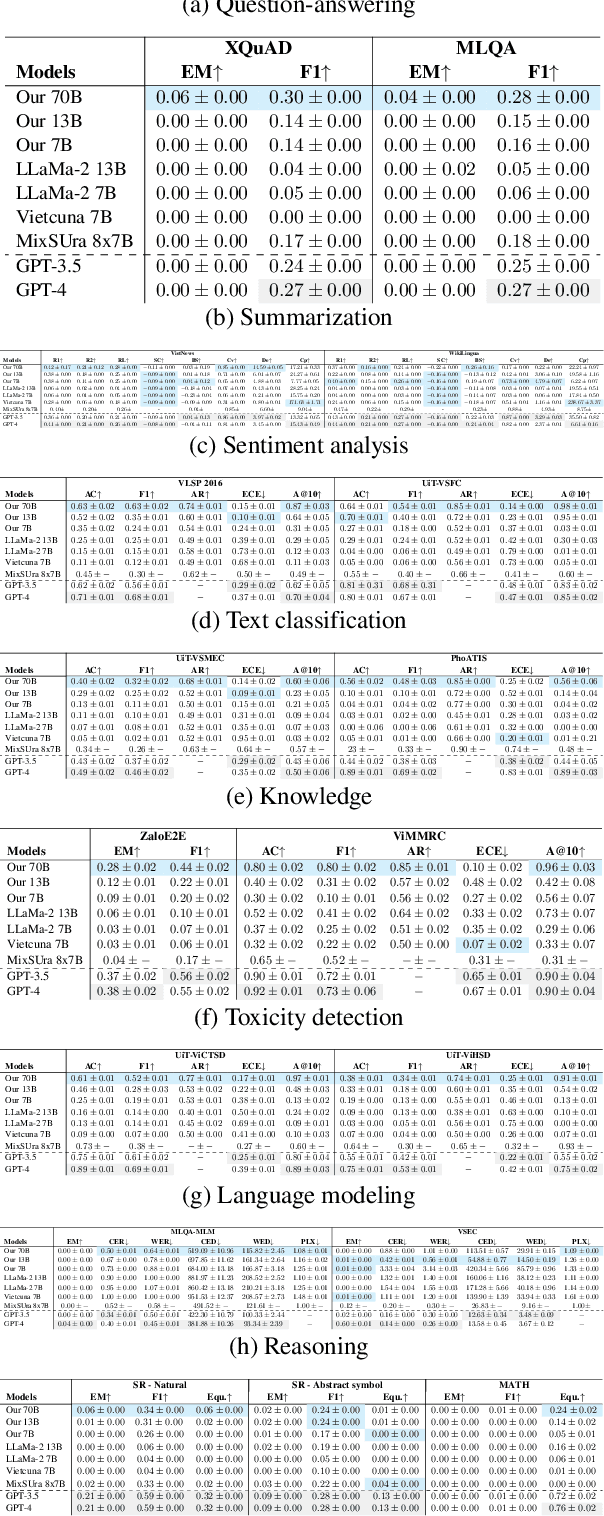
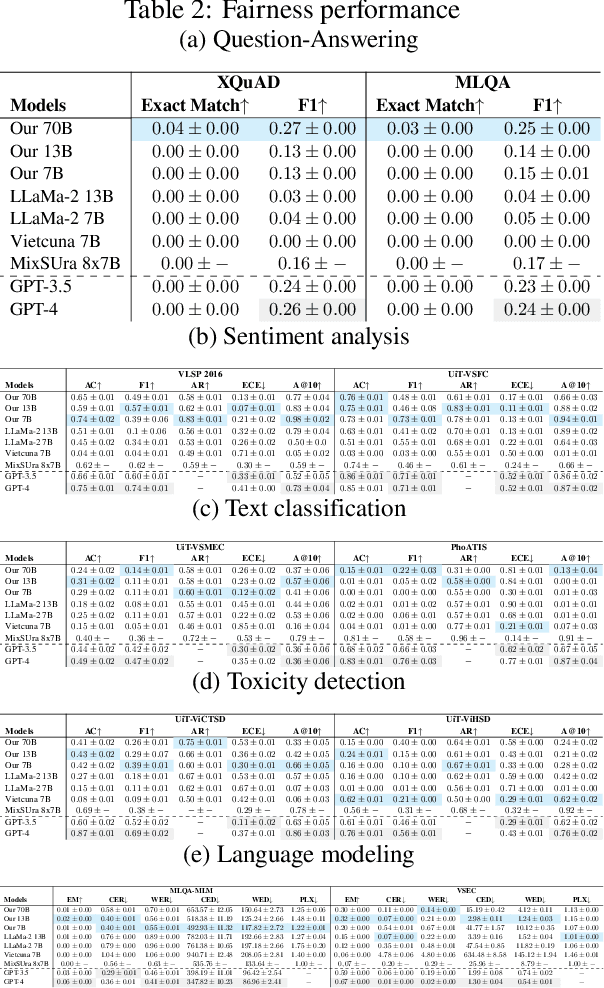
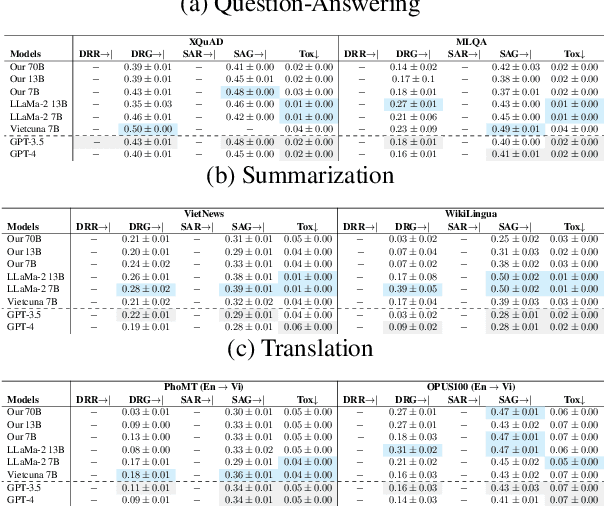

Abstract:Recent advancements in large language models (LLMs) have underscored their importance in the evolution of artificial intelligence. However, despite extensive pretraining on multilingual datasets, available open-sourced LLMs exhibit limited effectiveness in processing Vietnamese. The challenge is exacerbated by the absence of systematic benchmark datasets and metrics tailored for Vietnamese LLM evaluation. To mitigate these issues, we have finetuned LLMs specifically for Vietnamese and developed a comprehensive evaluation framework encompassing 10 common tasks and 31 metrics. Our evaluation results reveal that the fine-tuned LLMs exhibit enhanced comprehension and generative capabilities in Vietnamese. Moreover, our analysis indicates that models with more parameters can introduce more biases and uncalibrated outputs and the key factor influencing LLM performance is the quality of the training or fine-tuning datasets. These insights underscore the significance of meticulous fine-tuning with high-quality datasets in enhancing LLM performance.
Variational Flow Models: Flowing in Your Style
Feb 05, 2024



Abstract:We introduce a variational inference interpretation for models of "posterior flows" - generalizations of "probability flows" to a broader class of stochastic processes not necessarily diffusion processes. We coin the resulting models as "Variational Flow Models". Additionally, we propose a systematic training-free method to transform the posterior flow of a "linear" stochastic process characterized by the equation Xt = at * X0 + st * X1 into a straight constant-speed (SC) flow, reminiscent of Rectified Flow. This transformation facilitates fast sampling along the original posterior flow without training a new model of the SC flow. The flexibility of our approach allows us to extend our transformation to inter-convert two posterior flows from distinct "linear" stochastic processes. Moreover, we can easily integrate high-order numerical solvers into the transformed SC flow, further enhancing sampling accuracy and efficiency. Rigorous theoretical analysis and extensive experimental results substantiate the advantages of our framework.
Domain Generalisation via Risk Distribution Matching
Oct 28, 2023



Abstract:We propose a novel approach for domain generalisation (DG) leveraging risk distributions to characterise domains, thereby achieving domain invariance. In our findings, risk distributions effectively highlight differences between training domains and reveal their inherent complexities. In testing, we may observe similar, or potentially intensifying in magnitude, divergences between risk distributions. Hence, we propose a compelling proposition: Minimising the divergences between risk distributions across training domains leads to robust invariance for DG. The key rationale behind this concept is that a model, trained on domain-invariant or stable features, may consistently produce similar risk distributions across various domains. Building upon this idea, we propose Risk Distribution Matching (RDM). Using the maximum mean discrepancy (MMD) distance, RDM aims to minimise the variance of risk distributions across training domains. However, when the number of domains increases, the direct optimisation of variance leads to linear growth in MMD computations, resulting in inefficiency. Instead, we propose an approximation that requires only one MMD computation, by aligning just two distributions: that of the worst-case domain and the aggregated distribution from all domains. Notably, this method empirically outperforms optimising distributional variance while being computationally more efficient. Unlike conventional DG matching algorithms, RDM stands out for its enhanced efficacy by concentrating on scalar risk distributions, sidestepping the pitfalls of high-dimensional challenges seen in feature or gradient matching. Our extensive experiments on standard benchmark datasets demonstrate that RDM shows superior generalisation capability over state-of-the-art DG methods.
Open-Vocabulary Affordance Detection using Knowledge Distillation and Text-Point Correlation
Sep 19, 2023Abstract:Affordance detection presents intricate challenges and has a wide range of robotic applications. Previous works have faced limitations such as the complexities of 3D object shapes, the wide range of potential affordances on real-world objects, and the lack of open-vocabulary support for affordance understanding. In this paper, we introduce a new open-vocabulary affordance detection method in 3D point clouds, leveraging knowledge distillation and text-point correlation. Our approach employs pre-trained 3D models through knowledge distillation to enhance feature extraction and semantic understanding in 3D point clouds. We further introduce a new text-point correlation method to learn the semantic links between point cloud features and open-vocabulary labels. The intensive experiments show that our approach outperforms previous works and adapts to new affordance labels and unseen objects. Notably, our method achieves the improvement of 7.96% mIOU score compared to the baselines. Furthermore, it offers real-time inference which is well-suitable for robotic manipulation applications.
Language-Conditioned Affordance-Pose Detection in 3D Point Clouds
Sep 19, 2023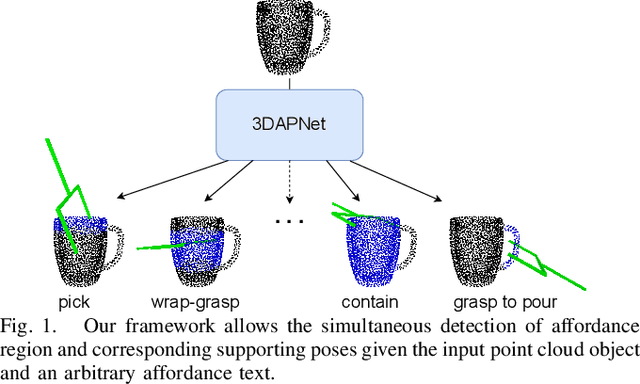
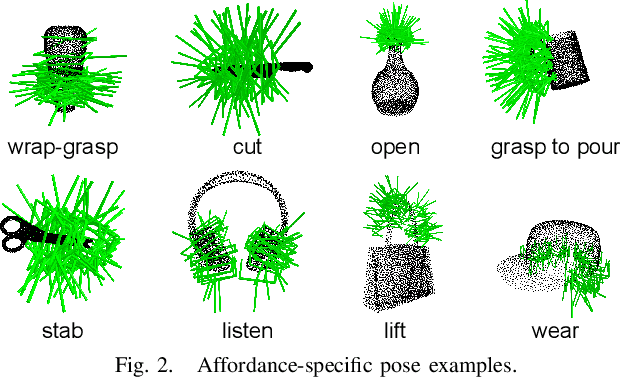
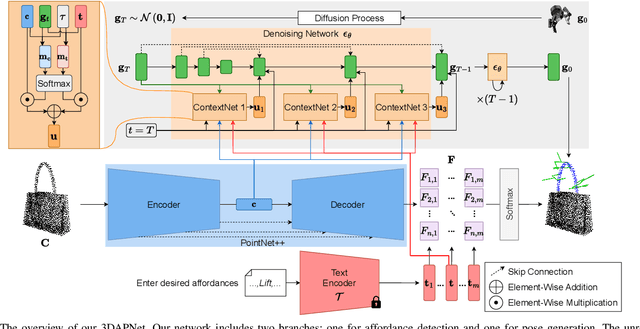
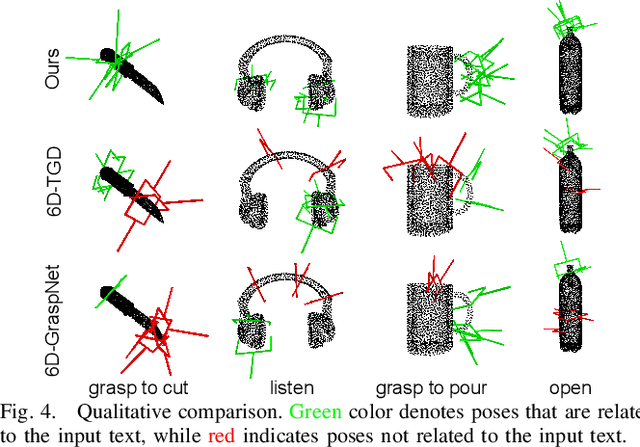
Abstract:Affordance detection and pose estimation are of great importance in many robotic applications. Their combination helps the robot gain an enhanced manipulation capability, in which the generated pose can facilitate the corresponding affordance task. Previous methods for affodance-pose joint learning are limited to a predefined set of affordances, thus limiting the adaptability of robots in real-world environments. In this paper, we propose a new method for language-conditioned affordance-pose joint learning in 3D point clouds. Given a 3D point cloud object, our method detects the affordance region and generates appropriate 6-DoF poses for any unconstrained affordance label. Our method consists of an open-vocabulary affordance detection branch and a language-guided diffusion model that generates 6-DoF poses based on the affordance text. We also introduce a new high-quality dataset for the task of language-driven affordance-pose joint learning. Intensive experimental results demonstrate that our proposed method works effectively on a wide range of open-vocabulary affordances and outperforms other baselines by a large margin. In addition, we illustrate the usefulness of our method in real-world robotic applications. Our code and dataset are publicly available at https://3DAPNet.github.io
Question-Context Alignment and Answer-Context Dependencies for Effective Answer Sentence Selection
Jun 03, 2023Abstract:Answer sentence selection (AS2) in open-domain question answering finds answer for a question by ranking candidate sentences extracted from web documents. Recent work exploits answer context, i.e., sentences around a candidate, by incorporating them as additional input string to the Transformer models to improve the correctness scoring. In this paper, we propose to improve the candidate scoring by explicitly incorporating the dependencies between question-context and answer-context into the final representation of a candidate. Specifically, we use Optimal Transport to compute the question-based dependencies among sentences in the passage where the answer is extracted from. We then represent these dependencies as edges in a graph and use Graph Convolutional Network to derive the representation of a candidate, a node in the graph. Our proposed model achieves significant improvements on popular AS2 benchmarks, i.e., WikiQA and WDRASS, obtaining new state-of-the-art on all benchmarks.
 Add to Chrome
Add to Chrome Add to Firefox
Add to Firefox Add to Edge
Add to Edge